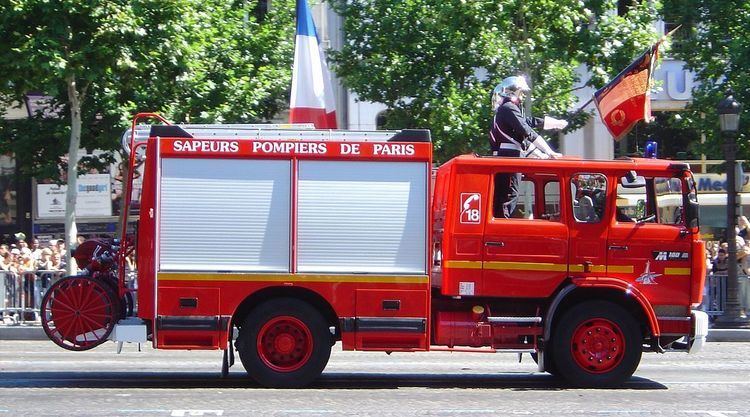Active 1793–present Size 8,500 | Country France Type Firemen | |
 | ||
Motto(s) "Sauver ou périr" (Save or Perish) | ||
The Paris Fire Brigade (French Brigade des sapeurs-pompiers de Paris, BSPP), is a French Army unit which serves as the primary fire and rescue service for Paris and certain sites of national strategic importance.
Contents
- Mission
- Special missions for Bastille Day
- History
- Selection and training
- Corporate Organisation
- Field Organisation
- First fire group Premier groupement dincendie
- Second fire group Deuxime groupement dincendie
- Third fire group Troisime groupement dincendie
- Training Group Groupement dinstruction
- Special Services
- Frequency of Operations
- References
The brigade's main area of responsibility is the City of Paris and the surrounding départements of Seine-Saint-Denis, Val-de-Marne, and Hauts-de-Seine. It also serves the Centre Spatial Guyanais in Kourou, the Military Rocket Test Centre in Biscarosse, and the gas plant of Lacq-Artix.
The brigade is a unit of the French Army's Engineering Arm (l'arme du génie) and the firefighters are therefore sappers (sapeurs, thus sapeurs-pompiers). With 8,550 firemen, it is the largest fire brigade in Europe and the third largest urban fire service in the world, after the Tokyo Fire Department and New York City Fire Department. The brigade is placed at the disposal of the Paris Prefecture of Police in an arrangement similar to that of the French Gendarmerie. Its motto is "Save or Perish" (French "Sauver ou périr").
Another military force responsible for firefighting in France is the Marseille Naval Fire Battalion (BMPM). The remainder of France has civilian fire and rescue services (services départementaux d'incendie et de secours). See: Fire service in France
Mission
As any French firefighter, their missions are
- Fire Suppression
- Emergency Basic Life Support ambulance
- Utility Safety – Gas Leaks et al.
- Personal Assistance – Victims services, SAR lost persons
- Motor vehicle collision response
- Protection of beings
- Patrol, Reconnaissance and Research
- Animal rescue
- Pollution control and HAZMAT Response
- Alarm response
They defend Paris and its "little crown" (close suburbs), but also specific sites:
Special missions for Bastille Day
Traditionally, the Paris Fire Brigade parades twice during the Bastille Day military parade: once on foot, and a second time with its vehicles. During the parade members are armed with the FAMAS, the famous French bullpup-style assault rifle, reminding them of their membership in the armed forces. Different fire stations of the Paris Fire Brigade organize each July 13 or 14th an evening dance party within the walls of the barracks, called Bal des pompiers (firemen's ball in English).
History
Founded in 1793 as the Corps des gardes-pompes de la ville de Paris and following the 23-hour Austrian Embassy Fire in 1810 became a military organisation by imperial decree by Emperor Napoléon. On 18 September 1811, it became the Bataillon de sapeurs-pompiers de Paris and was expanded to the Régiment de sapeurs-pompiers de Paris in 1867. On 1 March 1967 became the Brigade des sapeurs-pompiers de Paris.
Selection and training
The operational personnel (hommes du rang i.e. privates) are usually engaged for five years. They must have French nationality, be between 18 and 25 years old, have a clean criminal record and have at least a vocational training CAP certificate. The selection is three days long, with sports tests, psychomotor tests, medical examination, etc.
Training takes place in the Instruction Grouping (Groupement d'instruction, GI), at the fort of Villeneuve-Saint-Georges. The first period lasts two months, with the first aid and first responder training, and basic military instruction (including shooting).
The sapper then undertakes practical training of four months in an operational fire company (compagnie d'incendie); he takes part in personal assistance and utility safety operations.
The sapper then returns to the Instruction Grouping for two further months for his fire training. He is then permanently attached to a fire company.
Corporate Organisation
The brigade is commanded by a Brigade General as part of the French Army's engineering arm. The brigade commander directly controls the Information and Public Relations Bureau, and who is assisted a Colonel-Adjutant, a General Council called a Cabinet and a Chief of Staff who controls the following Bureaus:
and three Assistant Chiefs of Staff:
Field Organisation
each contains eight Fire companies and an Emergency medical service
First fire group (Premier groupement d'incendie)
The First fire group of the Paris Fire Brigade covers Northeast Paris and Seine-Saint-Denis and is Headquartered at:
and consist of the following units:
and 8 Fire Companies (CEI)
Second fire group (Deuxième groupement d'incendie)
The Second Fire Group of the Paris Fire Brigade covers Southeast Paris and Val-de-Marne and is Headquartered at:
and consist of the following:
and 8 Fire Companies (CEI)
Third fire group (Troisième groupement d'incendie)
The Third Fire Group of the Paris Fire Brigade covers Western Paris and Hauts-de-Seine and is Headquartered at:
and consists of the following units:
and 8 Fire Companies:
Training Group (Groupement d'instruction)
The Training Group of the Paris Fire Brigade provides education and training to all Paris firefighters. It consists of the following:
Special Services
Controlled by Headquarters
Frequency of Operations
The BSPP performs about 1200 interventions per day. During 2001:
There are 6.16 million inhabitants in the BSPP zone (1999). This represents:
